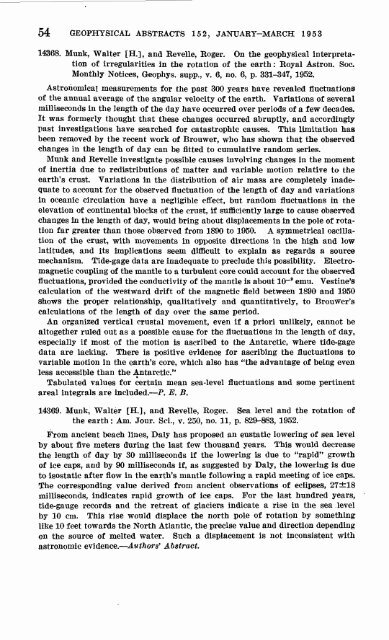Geophysical Abstracts 152 January-March 1953
Geophysical Abstracts 152 January-March 1953
Geophysical Abstracts 152 January-March 1953
You also want an ePaper? Increase the reach of your titles
YUMPU automatically turns print PDFs into web optimized ePapers that Google loves.
54 GEOPHYSICAL ABSTRACTS <strong>152</strong>, JANUARY-MARCH <strong>1953</strong><br />
14368. Munk, Walter [H.], and Revelle, Roger. On the geophysical interpreta<br />
tion of irregularities in the rotation of the earth: Royal Astron. Soc.<br />
Monthly Notices, Geophys. supp., v. 6, no. 6, p. 331-347, 1952.<br />
Astronomical measurements for the past 300 years have revealed fluctuations<br />
of the annual average of the angular velocity of the earth. Variations of several<br />
milliseconds in the length of the day have occurred over periods of a few decades.<br />
It was formerly thought that these changes occurred abruptly, and accordingly<br />
past investigations have searched for catastrophic causes. This limitation has<br />
been removed by the recent work of Brouwer, who has shown that the observed<br />
changes in the length of day can be fitted to cumulative random series.<br />
Munk and Revelle investigate possible causes involving changes in the moment<br />
of inertia due to redistributions of matter and variable motion relative to the<br />
earth's crust. Variations in the distribution of air mass are completely inade<br />
quate to account for the observed fluctuation of the length of day and variations<br />
in oceanic circulation have a negligible effect, but random fluctuations in the<br />
elevation of continental blocks of the crust, if sufficiently large to cause observed<br />
changes in the length of day, would bring about displacements in the pole of rota<br />
tion far greater than those observed from 1890 to 1950. A symmetrical oscilla<br />
tion of the crust, with movements in opposite directions in the high and low<br />
latitudes, and its implications seem difficult to explain as regards a source<br />
mechanism. Tide-gage data are inadequate to preclude this possibility. Electro<br />
magnetic coupling of the mantle to a turbulent core could account for the observed<br />
fluctuations, provided the conductivity of the mantle is about 10~~9 emu. Vestine's<br />
calculation of the westward drift of the magnetic field between 1890 and 1950<br />
shows the proper relationship, qualitatively and quantitatively, to Brouwer's<br />
calculations of the length of day over the same period.<br />
An organized vertical crustal movement, even if a priori unlikely, cannot be<br />
altogether ruled out as a possible cause for the fluctuations in the length of day,<br />
especially if most of the motion is ascribed to the Antarctic, where tide-gage<br />
data are lacking. There is positive evidence for ascribing the fluctuations to<br />
variable motion in the earth's core, which also has "the advantage of being even<br />
less accessible than the Antarctic."<br />
Tabulated values for certain mean sea-level fluctuations and some pertinent<br />
areal integrals are included. P. E. B.<br />
14369. Munk, Walter [H.], and Revelle, Roger. Sea level and the rotation of<br />
the earth: Am. Jour. Sci., v. 250, no. 11, p. 829-883, 1952.<br />
From ancient beach lines, Daly has proposed an eustatic lowering of sea level<br />
by about five meters during the last few thousand years. This would decrease<br />
the length of day by 30 milliseconds if the lowering is due to "rapid" growth<br />
of ice caps, and by 90 milliseconds if, as suggested by Daly, the lowering is due<br />
to isostatic after flow in the earth's mantle following a rapid meeting of ice caps.<br />
The corresponding value derived from ancient observations of eclipses, 27±18<br />
milliseconds, indicates rapid growth of ice caps. For the last hundred years,<br />
tide-gauge records and the retreat of glaciers indicate a rise in the sea .level<br />
by 10 cm. This rise would displace the north pole of rotation by something<br />
like 10 feet towards the North Atlantic, the precise value and direction depending<br />
on the source of melted water. Such a displacement is not inconsistent with<br />
astronomic evidence. Authors' Abstract.

















